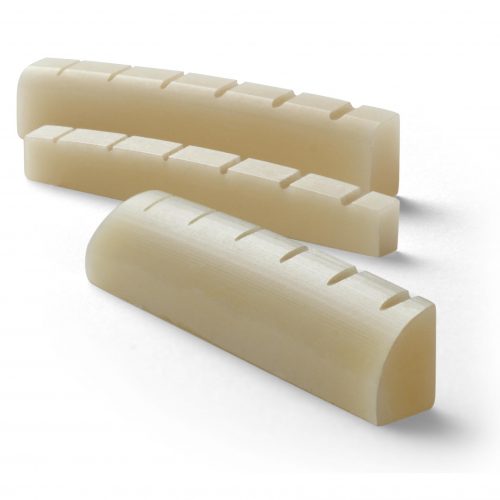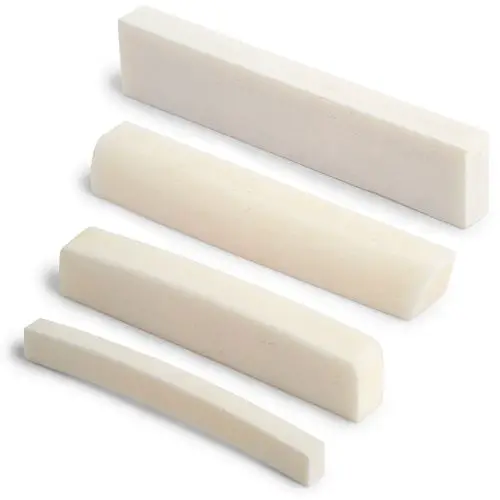Bone nuts should sound better than typical plastic nuts that come with many guitars.
It helps to produce fuller tones – where the lows are louder and highs are sharp and clear. Bone nuts also increase tone sustain.
Generally, nuts other than the plastic ones will perform much better in terms of tone and reliability.
I personally have tried different guitar nuts like plastic, bones, synthetic bones and Tusq. I can tell there is a sound difference – especially when you play them side by side.
In this article, I am going to talk about bone nuts in more detail. This should cover everything you need to know and by the end, you can decide whether you should switch to a bone nut or not.
The things I will cover:
- Effects Of Bone Nuts To Guitar Note (Sound Difference)
- Pros & Cons Of Bone Nuts For Guitar
- Bone Nuts Vs Synthetic Bone Nut
- Are Bone Nuts Made Of Real Bone?
- How Much Does Bone Nut Replacement Cost?
- How Can You Tell If a Guitar Nut Is Bone?
- Should You Get A Bone Nut?
Effects Of Bone Nutes To Guitar Note (Sound Difference)
With bone nuts, your guitar will produce a much fuller tone – where the lows are loud and highs are sharp and clear.
Bone nuts also help in improving sustain – this is when you pluck a string and the sound plays much longer than before.
Bone nuts are much harder and denser than regular plastic nuts. This means they help transfer sound vibrations better – causing longer sustain and improved tone (vibrations are not absorbed).
On the other hand, plastic nuts are softer and hollow. They absorb lots of sound vibrations – making your guitar sound dull. This is noticeable when switching to bone nuts.
Note that when you fret or form chords, the nuts are not fully used – in this case your fingers become the ‘nut’.
To test the sound difference of a nut, you need to ring the guitar with open notes (no fretting or forming chords).
Pros & Cons Of Bone Nuts For Guitar
Here’s a full list of the advantages and disadvantages of bone nuts. TLDR – bone nuts are great for tone, sustain and reliability but they are more expensive and inconsistent.
4 Advantages of bone nut
- Creates a fuller tone. Bone nuts are more dense and can help with transferring sound vibrations. This means your highs and lows can be clearly heard.
- Creates a longer sustain. Bone nuts are hard and they are not hollow – which means they don’t absorb sound vibrations. This is great for longer sustain and let the sound ring longer.
- Lasts longer. Bone nuts are hard and do not get worn out easily. You can expect a bone nut to last very long – even if you are using tremolo a lot, where the string frictions are common.
- Can hold tuning well. Great bone nuts are cut and shaped specifically for your guitar. This is great for creating cuts that are perfect to hold your strings and place and get them to stay in tune.

Bone nuts are hard and do not absorb sound vibrations – helping you create better tone.
3 Disadvantages of bone nut
- Inconsistent filling. Bone nuts are natural and are crafted from real bones. This means the filling could be inconsistent – some parts are filled well while others are a little hollow. This means the sound experience between each string may not be consistent – some is better than the others.
- May need lubrication. You need to lubricate bone nuts from time to time if you play a lot with trems. Bone nuts will not self lubricate like Tusq nuts.
- Can be expensive. Additional labor is required to cut and shape the bone nuts specifically for your guitar. This makes bone nuts more expensive than regular pre-cut nuts. I got mine for $80. More on pricing later.
Bone Nuts Vs Synthetic Bone Nut
Bone nuts provide better sound and hold tune longer than synthetic bone nuts. Synthetic bone nuts are just very hard plastic with bone powder.
Synthetic bone nuts are also precut – which means they are not created specifically to suit your guitar and will not hold tuning as long.
Many guitars come with synthetic bone nuts today. General rule of thumb is not to replace it if you feel it’s ok and can hold the tune.
Look to replace your nut only if you have a problem with the current. Otherwise, if it ain’t broke, dont fix it.
Such guitar problems that could be solved by replacing nuts include:
- Doesn’t hold tune
- Short sustain
- Dull sounds
Are Bone Nuts Made Of Real Bone?
Bone nuts are made of real bones – usually from cow or camel legs, which are strong, dense and readily available for cheap.
In the previous years, elephant ivory was the go to for bone nuts. However, the elephants are getting endangered and cow bones are now the go to.
That said, manufacturers generally don’t tell you what animals are used for the bones – so I wouldn’t be surprised if other species are used.
But to answer the question – yes, real bones are used in making guitar bone nuts.
How Much Does Bone Nut Replacement Cost?
Custom bone nuts that are cut and shaped specifically for your guitar can cost from $55 to $90 – depending on the luthier and your area.
Generally, the materials used for bone nuts are cheap. The thing that costs the most is the labor. A great deal of experience and precision are required to craft a good bone nut – the spacing, angles and shapes must be perfect.
A luthier would create bone nuts using a blank (just a block of bone nut). Depending on your guitar, the luthier will then create the cuts and shapes using files and other tools.

Bone nuts are shaped and cut from a blank for your guitar.
How Can You Tell If a Guitar Nut Is Bone?
The best way to know if your guitar nut is made of bone, is by getting that info from the manufacturer – through websites or customer support.
If that route is not possible, then there are other ways (although not so accurate and requires your own judgement).
I know some guitarists will suggest ways like burning them and smelling them after or using needles to poke them. I think those ways are absurd and can be damaging. Thus, I won’t recommend it.
Instead, try these 3 methods to identify whether your guitar nut is made of bone or plastic:
- Gently tap the guitar nut with your finger nails. A bone nut will sound full and hard. Whereas plastic nuts are softer and hollow.
- Use magnifying glass to inspect the colors of the nut. Bone nuts are natural and not uniform in color. Whereas plastic nuts are made of plastic and will have a uniform color.
- Pluck the string and listen to the sustain. The sound coming from a guitar with bones has much longer sustain. You can compare your sustain with videos on YouTube. Pluck an open string gently.
Should You Get A Guitar Bone Nut?
For the best note and sustain, you should definitely opt for a bone nut – the tone improvements and sustain are way better than plastic nuts.
That said, if you don’t have any problem with your current guitar nut, then you shouldn’t change into a bone nut. It costs quite a lot at $55 (minimum) and you might not even like the change.
Also, if you are a beginner, then bone nuts will not benefit you. Just stick with whatever nuts that come with your guitar, since you shouldn’t be able to differentiate the tone difference anyway.






